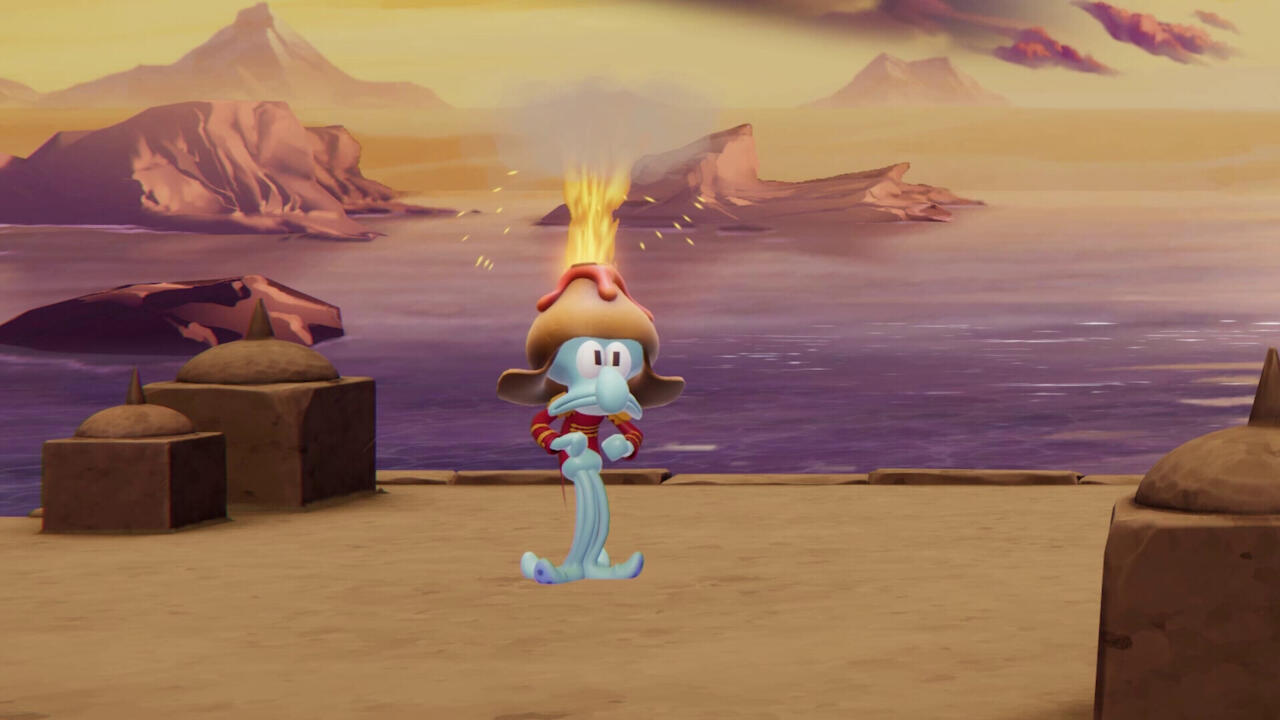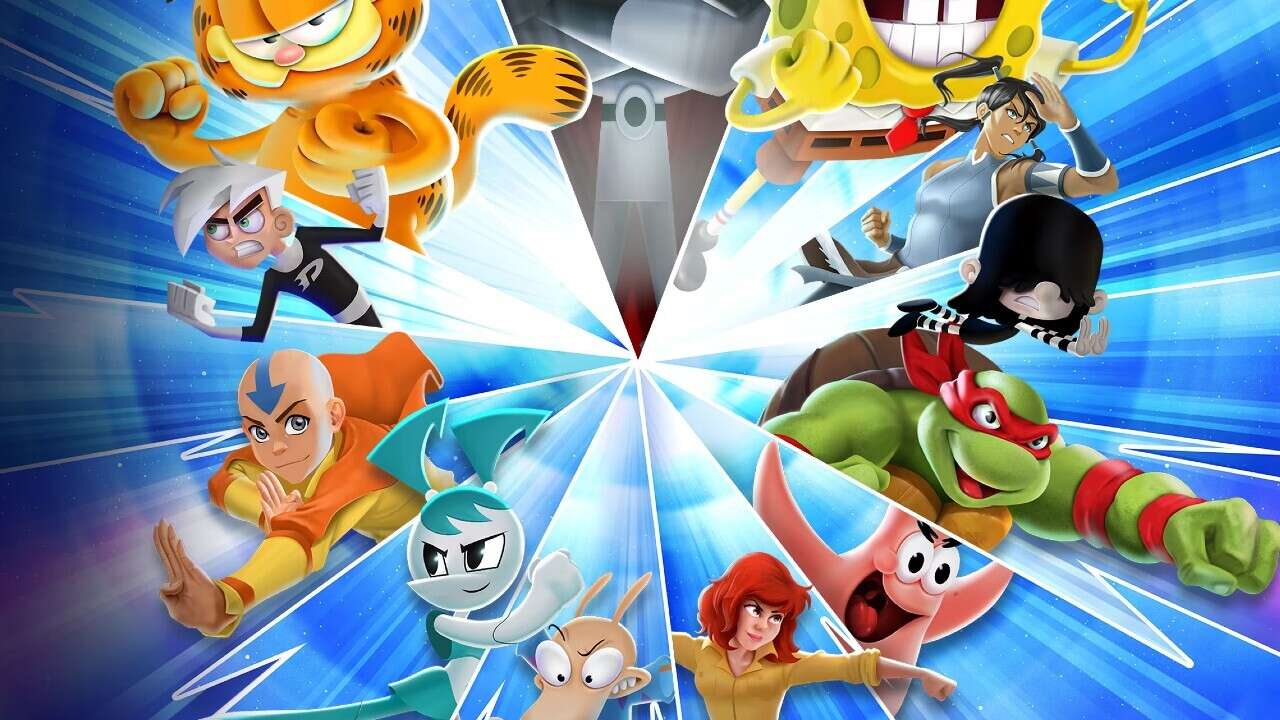Two years ago, Fair Play Labs and Ludosity entered the platform fighting game ring with Nickelodeon All-Star Brawl. The game was decent enough, but it was clear that the core “Smash Bros. with Nickelodeon characters” idea had more to offer than what was delivered. Now, with Nickelodeon All-Star Brawl 2, the two studios are attempting to realize that potential.. However, while some welcome adjustments have been made, there are a few important flaws–and some mind-boggling subtractions–that once again keep the full potential of this idea out of reach.
The most notable improvement Nick Brawl 2 makes over other platform fighters is its control scheme, which carries over from the previous game and yet still feels genuinely innovative. Character movement, shields, and throws are all standard fare: You move your character with the stick, press a shoulder button to grab for a throw, and press a different shoulder button to bring up shields or dodge opponents’ moves.
Attacking, on the other hand, uses a control scheme quite different from what you might expect from a platform fighter. Each character has three main attack buttons–light attack, charge attack, and special attack–and each button uses a different move if the joystick is held in a certain direction. Charge attacks in most other platform fighters have shared a button with light attacks, but Nick Brawl 2 separates them. This is a smart improvement, as it makes for easier combo execution in the heat of battle and allows for a few extra moves for each character. This game also made me appreciate jumping with a button instead of tilting the joystick up–by dedicating a button to jumping, using a upward charge attack becomes easier, as I don’t accidentally jump instead of attacking. I never used the button option in Smash, but Nick Brawl 2 has made me come around to the idea.
I also love the new slime meter mechanic, which operates exactly like EX bars in Street Fighter or Mortal Kombat. You accrue three bars of slime while fighting and can use those to enhance attacks, cancel moves, and air dash. Filling all three bars allows you to unleash a one-time super move that hits for massive damage. The addition of a meter isn’t new–Smash Bros. Ultimate did the same–but adding EX moves and meter-focused cancels is new for this format, and it works well. By implementing a meter system that gives each character more tools to work with, instead of just offering a meter with only one function, there’s more room for experimentation with each character, and that means more fun in each match.
Speaking of the roster, it’s one of the most confounding design choices in the entire game. Nick Brawl 2 contains 25 fighters–the same number as the previous game once all downloadable content had been released–with 14 fighters returning from Nick Brawl 1 and the remaining 11 making their franchise debut. Some of the new additions are deserved–Plankton commandeering a giant mech version of himself is hilarious–but others like Hey Arnold’s Grandma Gertie don’t fit as well, especially when, like in Gertie’s case, the title character Arnold isn’t here.
However, if you’re following the math, you’ll notice that this means 11 fighters from the previous game were left out. Some of them aren’t huge losses–few people are going to cry over the loss of Oblina from Aahhh! Real Monsters or Sandy the Squirrel from SpongeBob–but others left me scratching my head. It’s cool that TMNT’s Donatello and Raphael join the fight this time, but why did that come at the expense of Michaelangelo and, more importantly, the team leader Leonardo? Lucy Loud from the Loud House returns, but Lincoln Loud is left by the wayside. There’s no apparent logic behind these roster cuts, and players who used these characters are going to be left in the lurch.
What’s worse, a handful of the cut characters appear in Nick Brawl 2 in some capacity, which rubs salt in the wound of their exclusion. Shredder has been limited to a non-playable boss character. Hugh Neutron now appears in the campaign mode offering free items to the player, with his fighting days seemingly over in favor of his son, Jimmy. The aforementioned Lincoln Loud can be seen in the background of The Loud House stage–in his idle animation from the last game, no less.
Thankfully, despite the weird makeup of the roster, every fighter has a lot to offer. Each of the 14 returning fighters have been considerably reworked, to the point where they feel like new fighters in their own right. April O’Neil and Korra feel particularly strong in this game thanks to some powerful charge attacks and versatile mobility options. The new characters have a lot of fun and unique movesets to explore as well; I’m particularly fond of the Angry Beavers and their Ice-Climbers-esque two-in-one approach. While I may have concerns with how the roster was concocted, I can’t deny that those who made the cut have really fun designs.
The roster choices may be questionable, but the available modes in Nick Brawl 2 are a major improvement from its predecessor thanks to a deeper single-player experience. Some platform fighter standards like local and online versus battles, team battles, and training modes return, but the single-player offerings are far more robust. The arcade mode is the usual series of battles in succession, but you’re offered opponent choices in some stages as opposed to simply following a linear path. The choices don’t add much, admittedly, but I like that I can choose.
The all-new campaign mode, meanwhile, follows a structure similar to the arcade mode, but with a few additions. For each run, the campaign takes elements from throughout Smash Bros’ single-player history and mixes them into a fine gumbo; there are brainwashed characters that become playable after they’re defeated like in Ultimate’s World Of Light, platforming sections like Brawl’s The Subspace Emissary and Melee’s Adventure mode, and checkpoints where characters like Mrs. Puff, the Cabbage Salesman, and the aforementioned Hugh Neutron offer items and power-ups.
What’s more, as opposed to the previous game, which launched with no voices, every character in this game is voiced, with the majority being performed by their original voice actor. Some even have unique dialogue when controlling certain characters: Mrs. Puff gets nervous around SpongeBob, Hugh goes full dad mode when Jimmy’s around, etc. The hub world between runs has a few opportunities for unique interactions as well, with Master Splinter giving the turtles and April specific advice, for example. The voices aren’t always a boon, though; sometimes skipping dialogue doesn’t stop playing it, which leads to Hugh Neutron talking about ducks and his son at the same time, among other weird moments.
Best of all, this campaign also includes an interesting twist: It’s a roguelite. You choose a character when leaving the hub to start a hub and must stay alive as long as possible through multiple paths–with damage carrying over from bout to bout–before it eventually culminates in the final battle against the main boss, Vlad Plasmius. Completing stages can unlock new characters by defeating them, and you earn currencies that can be used to unlock additional power-up slots, purchase one-time buffs for that run, and more. Some NPCs hold specific buffs, and visiting them multiple times can level up a particular buff you might be fond of. I never pictured fighting games and roguelite elements fitting together, but Nick Brawl 2 makes it work as well as adding chocolate to milk.
This approach is not entirely without issue, though, as some parts of the campaign work better than others. The paths through each section of a run aren’t always clear, so while planning a route, I sometimes got mixed up and ended up going a different way, which caused me to miss a specific character battle or item merchant as a result. The boss fights are fine; while some offer more challenge than others–the Flying Dutchman, in particular, is deviously tough–none of them move the needle in terms of new and exciting bosses. Most of the fights consist of a fighter spamming quick attacks, dodging a boss’s attack, and then continuing to spam until the boss dies. They’re not all that exciting, which is unfortunate.

Gallery
The worst part of the campaign, by a considerable margin, is the platforming sections. While the platforming mechanics work in battles, they do not translate well into pure platforming sections. Sluggish, slow jumping is met with imprecise ledge grabs and strange hit boxes on obstacles to create a maddening experience during every platforming challenge. I do appreciate that falling into a pit here only results in taking some damage, but when I fall so many times that I enter the next battle with 800 damage and only one stock left, I’m less hesitant to be thankful. Eventually, I began specifically planning my routes so I would avoid platforming stages, rather than focusing on the routes I genuinely wanted to take.
Nickelodeon All-Star Brawl 2 is a marked improvement over the previous game, with a solid fighting system, fun new ways to play, and a varied roster of characters from throughout Nickelodeon’s history. Each improvement comes with a catch, however, as funky platforming levels in campaign mode, weird roster choices, and more continue to hold the game back from its full potential.

